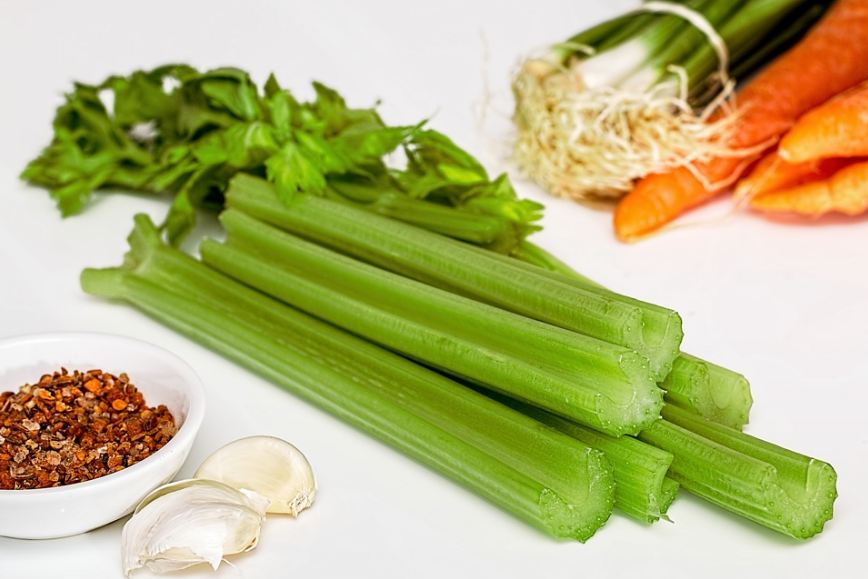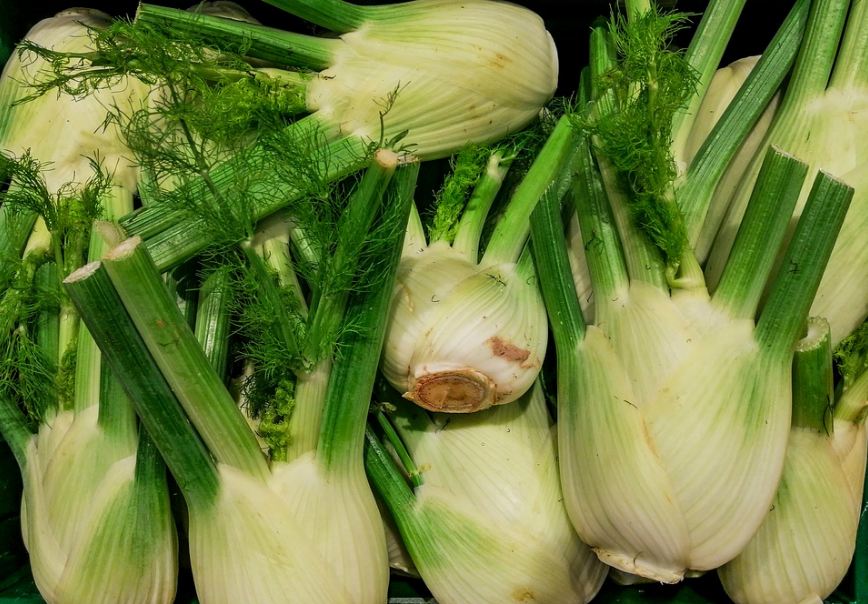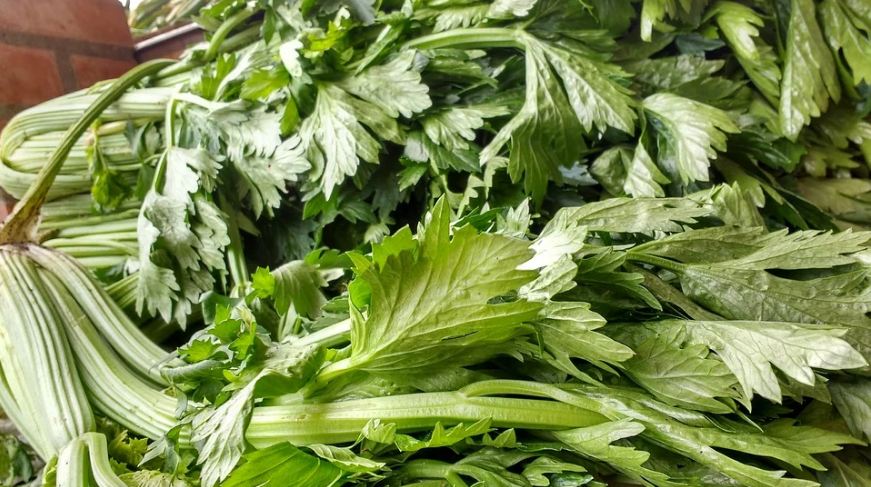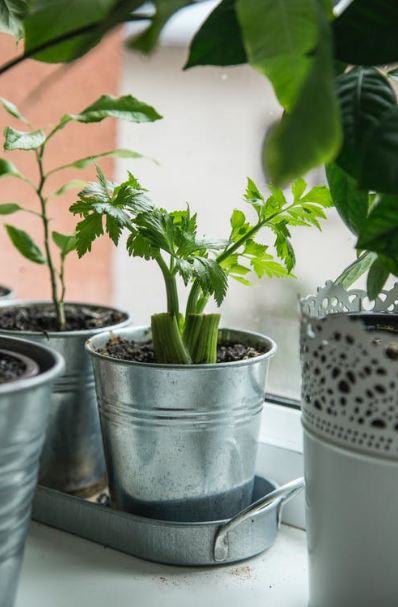Celery is a Mediterranean vegetable that belongs to the Apiaceae family. It is quite healthy and easy to grow. It has a tremendous crispy flavor, which you can easily recognize when you are drinking soup in which celery is mixed. You can eat it raw or use it to prepare juices, soups, stews, etc. It comes in different colors and varieties.
Celery is one of the highly cultivated vegetables around the world. It is a type of plant that you can grow successfully both indoors and outdoors or in your garden. That is why many people today opt for producing organic celery. This plant grows to 1mm in length. Its leaves are pinnate to bipinnate and have rhombic leaflets of 3-6cm long and 2-4cm broad.
This vegetable contains many vitamins, including vitamin A, vitamin B1, vitamin B2, vitamin B3, vitamin B5, vitamin B6, vitamin C, vitamin E, and vitamin K that help prevent or treat some diseases. The nutrients that this plant’s leaves contain can help prevent infection if you use them as vegetables.
Types of Celeries
1. Celery Root
Celery root, also known as celeriac, is mostly grown because of its delicious roots that you can consume both raw and cooked. Root celery is effortless to grow, even though it is better to grow it in a garden than in a pot.
Depending on the type of celery you choose, the roots can grow to a larger size, with the celery’s weight ranging from 3 to 4 pounds. You can also choose a smaller variety if your consumption requirements are less.
2. Celery Stalk
As you can tell by the name, the celery stalk is grown for its stalks. There are many varieties of this celery that are divided into self-blanching,green and red celery. The self-blanching celery is also known as yellow, and it is straightforward to grow. Golden Yellow Celery Hair loom is the most resistant.
The golden yellow is distinguished by lemon yellow stalks that grow to 2 feet tall and yellow leaves that make this celery great for decoration purposes. The red celery is not only indicated by its unusual color but also by its fantastic walnut taste.
3. Celery Leaf
Celery leaf is used in the making of soup, which is also known as soup celery. You can grow it in a pot, and it will develop leaves similar to parsley leaves. It has a great taste nutty taste that you would probably love—this is a type of celery that you can grow almost all the year.
Health Benefits of Celery
Here are some of the health benefits of Celery leaves for your body and beauty:
- Reducing high blood pressure
- It helps you cope with vertigo, a problem on the head of a seven-round pain in the head
- Overcoming the hind limbs, which have both fluid and less dangerous
- Overcome minor problems such as nausea, colds, coughs, and allergies.
- Overcoming rheumatism and gout
- It helps moisturize the eye so as not to dry
- Increases appetite
- Overcoming urination accompanied by blood
- Help overcome menopausal complaints
- For those of you who missed the period can often help to melancarakan coming months you
- It can be used as a fertilizer for hair to make it look denser
- Reducing cholesterol problems
Guide on Growing Celery in Your Yard
1. Choosing the Right Type Of Celery
You can grow celery either for its leaves, stalks, or roots, but you should take some time to choose the type of celery you want to grow. Out of the three celery categories, only the leaf celery, also known as soup celery, is primarily used for cooking, and the soup’s preparation is known as the ancient type.
The plants reach up to a height of 2 feet and do well in a colder environment. Usually, plants that are a height of six feet are enough for your home, and you can increase the plant’s yield by pruning it daily.
2. Planting Seeds
Once you have decided about the type of celery you want to grow, now is the time to start planting seeds. You need to have celery seeds, small pots, and some potting soil. But before planting, makes sure that you all the trays and pots you are using have drainage holes in them, and then fill 2/3 of the pot with potting soil.
Plant several seeds in each pot to ensure that at least one of them will be able to germinate. If you want to make the germination process a little faster, pre-wash the seeds in cold water for about 12 hours. After you plant the seeds, you should cover them with a 1-inch potting soil and water immediately. The soil should be wet but not washed.
3. Arranging Proper Shading
It would best if you transplanted the garden’s celery when the outside temperature is continuously above 50ᵒF as extreme temperatures are not suitable for growing celery. Therefore, you should kill your plants if the weather is below 50ᵒF.
To plant your celery, you need to find a sunny spot in your garden, preferably one with a little shade but where your plant will get about six hours of sunlight. If you live in an area where there is a warm climate, then it would be best to protect your celery from a large amount of heat during the hottest hours of the day by providing adequate shade.
4. Checking the Type of Soil
Celery grows in moist and highly-nutrient soil. But since it was originally a wild plant that grows in swamp areas, celery plants can easily deal with high moisture levels that most other vegetables cannot bear.
This might sound like good news to you if you are someone who wants to grow vegetables in the moist areas of your garden where nothing else is growing. But there is one thing to remember that you should not keep the terrain flooded. Therefore, it is an excellent idea to use a medium-draining.
5. Giving Adequate Space
Celery plants don’t need a large space to grow correctly, but still, you have to take care of some things to develop a healthy celery plant. The celery’s minimum spacing requirement should be 12-inches between each one of the two celery plants with a minimum of 18-inches of space between the rows.
The right spacing will allow the plant to grow to sufficient sunlight, and they will not need to compete for nutrients and water either. Additionally, it will also help you keep pests under control, as the regular spacing of the celery will help you spot and remove the pests easily without any problems.
6. Making Sure if The Temperature is Suitable
The minimum tolerable temperature for celery is about 50ᵒF, and it doesn’t tolerate temperatures above 70ᵒF. The suitable temperature range for growing celery should be between 55 and 70ᵒF.
That is why it is best to grow celery at the end of the summer, especially if you live in a place where the climate is warm because celery can get enough time to grow before mid-autumn. In the Mediterranean region, celery is a late-autumn or winter crop.
7. Fertilizing and Mulching Celery
If you want to grow healthy and robust celery plants, you should also fertilize the terrain regularly. It would be best to use the fertilizers from the third month of the celery plant’s growth. You should use a balanced fertilizer that is about 5-10-10 or 10-10-10 and manure tea.
Use the fertilizer around each plant while maintaining a distance of about four inches between them. One tablespoon of fertilizer is enough, and then you should cover the fertilizer with soil and water as needed.
8. Watering the Plant
As mentioned earlier, celery needs heavy feeding, meaning that it needs more water to grow. Lack of moisture in plants can change their flavor and make them bitter. That is the reason why you should make sure that the soil is moist all the time.
It is best to give your plants at least 2 inches of water per week, adjusting the amount according to the climate’s conditions.
Common Problems with Growing Celery
1. Mosaic Virus
Mosaic Virus is typically transmitted by aphids. This virus creates yellow mosaic patches on the leaves that make them wrinkled and curly. The plants die after a short time when they are exposed to this virus.
You can prevent your plants from getting the mosaic virus by having adequate protection against the aphids. One thing to remember is that weed can increase the chances of getting the disease. Therefore, it is best to mulch around the celery plants greatly. Rotating the crops is also helpful.
2. Early Blight
Early Blight is a disease that causes small yellow spots on the leaves to appear that eventually transform into circular and gray lesions. Firstly, to solve this issue, you need to make sure that the seeds you planted are healthy either by buying certified ones from the store or soaking the seeds in hot water before planting.
Ensure you are giving it the right amount of water and fertilizers as they help manage the symptoms of early Blight by assisting the plant in developing its self-defense system. Taking care of space requirements and not watering the leaves are other methods that can help prevent early Blight without fungicides.
3. Pink Rot
Pink Rot is a disease that is caused by a fungus known as Sclerotia in celery plants. Pink Rot causes brown lesions to appear on the petioles and leaves. These lesions transform very quickly into soft areas of decay, and nearby tissue turns pink.
It makes the celery base collapse at some point. To prevent the disease, take care of the spacing and the watering requirements of the plant. Moreover, avoid watering the leaves of the plant.
4. Bacterial Leaf Spot
Bacterial Leaf Spot causes brown spots on plants that are soaked in water on the leaves that will turn yellow as time passes. This disease develops in lower temperatures. To prevent this disease, you can either rotate your crop or remove the infected plants.
Also, do not water the leaves in the later development stages of the crops. It is best to use a soaking hose for irrigation to prevent this disease.
Celery – A Very Beneficial Vegetable
Celery plants are a great source of vitamins that can be grown both indoors and outdoors. They have a crispy flavor, and you can use them to make soup, juice, etc. These plants also have many health benefits, including healthy gut lining and digestion, and more. It would be best to consider some things before growing celery in your home, for instance, temperature requirements.






